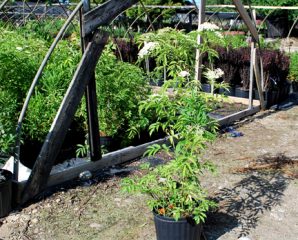Not many people realize that this shrub even exists until they’re seen along the road in full bloom! Sambucus canadensis, also called American Elderberry, is one of those shrubs that’s either loved by native plant aficionados or demanded by town Wetland Commissions – and not so much in between.
It’s a fast growing, rounded shrub typically found along the edges of ponds and wetlands, roadside drainage areas and forest edges. It leafs out early spring with compound leaves and is followed by large, flat-topped, white lacey clusters of flowers late June. The flowers develop into black edible berries (think jam, jelly and wine!). No need to mention, birds love them!
They’re happy along a pond or low areas in the landscape. Plant in full sun or partial shade in moist soil. They do not want to be planted in water, but because they have a shallow root system they can be planted at the high edges of ponds and wetlands. Now, don’t feel restricted by the mention of ‘wetlands’, they’re pretty tolerant of dry soil once established and could look great in the shrub border, as an informal hedge or along a driveway. Prune after flowering to keep its size in check if needed (they will get 6-12′ h x w) and cut out any suckers to encourage an arching vase-shape. They’re one flowering shrub that comes through winter after winter with no issues – hardy Zone 3-8.

